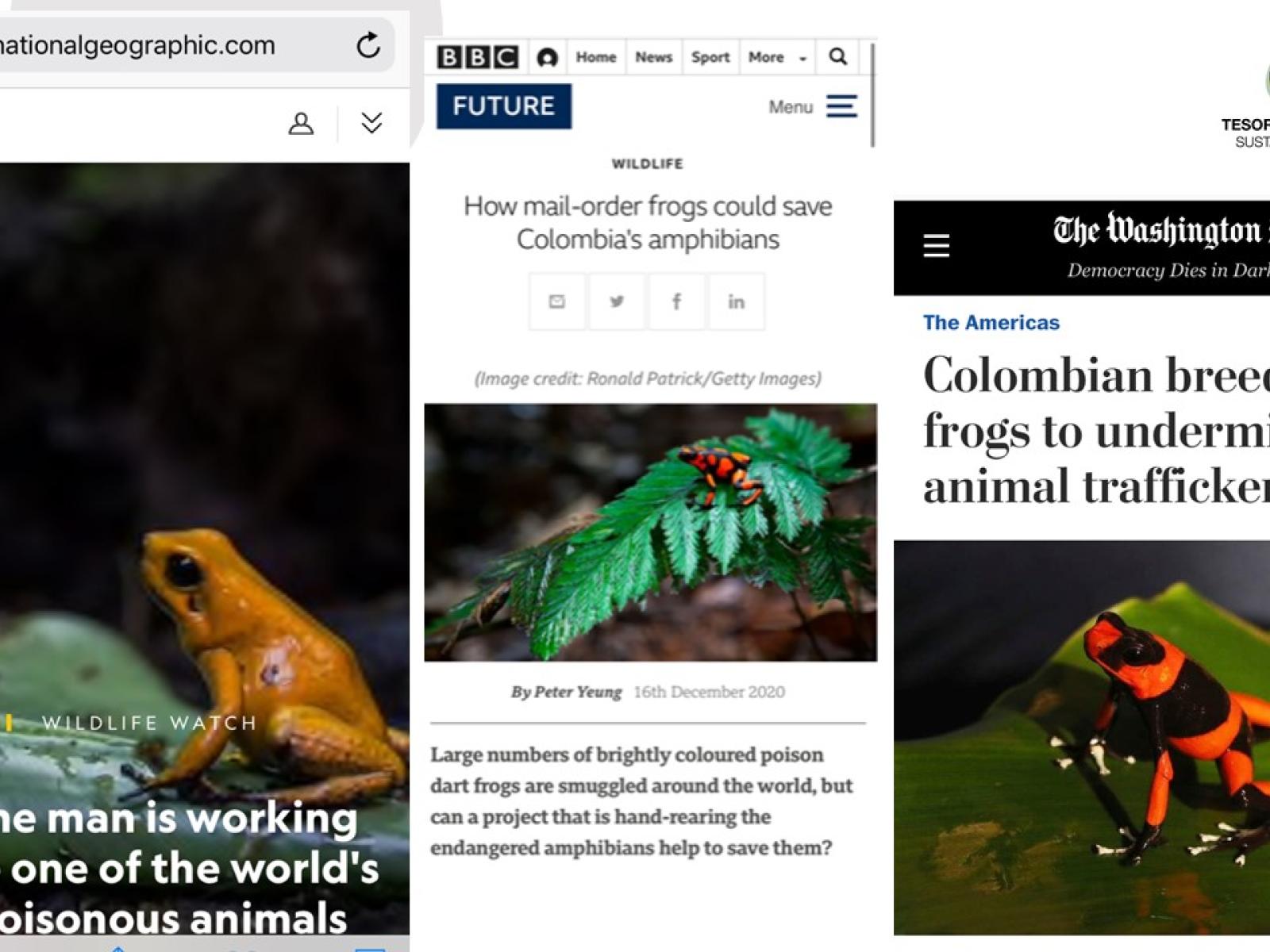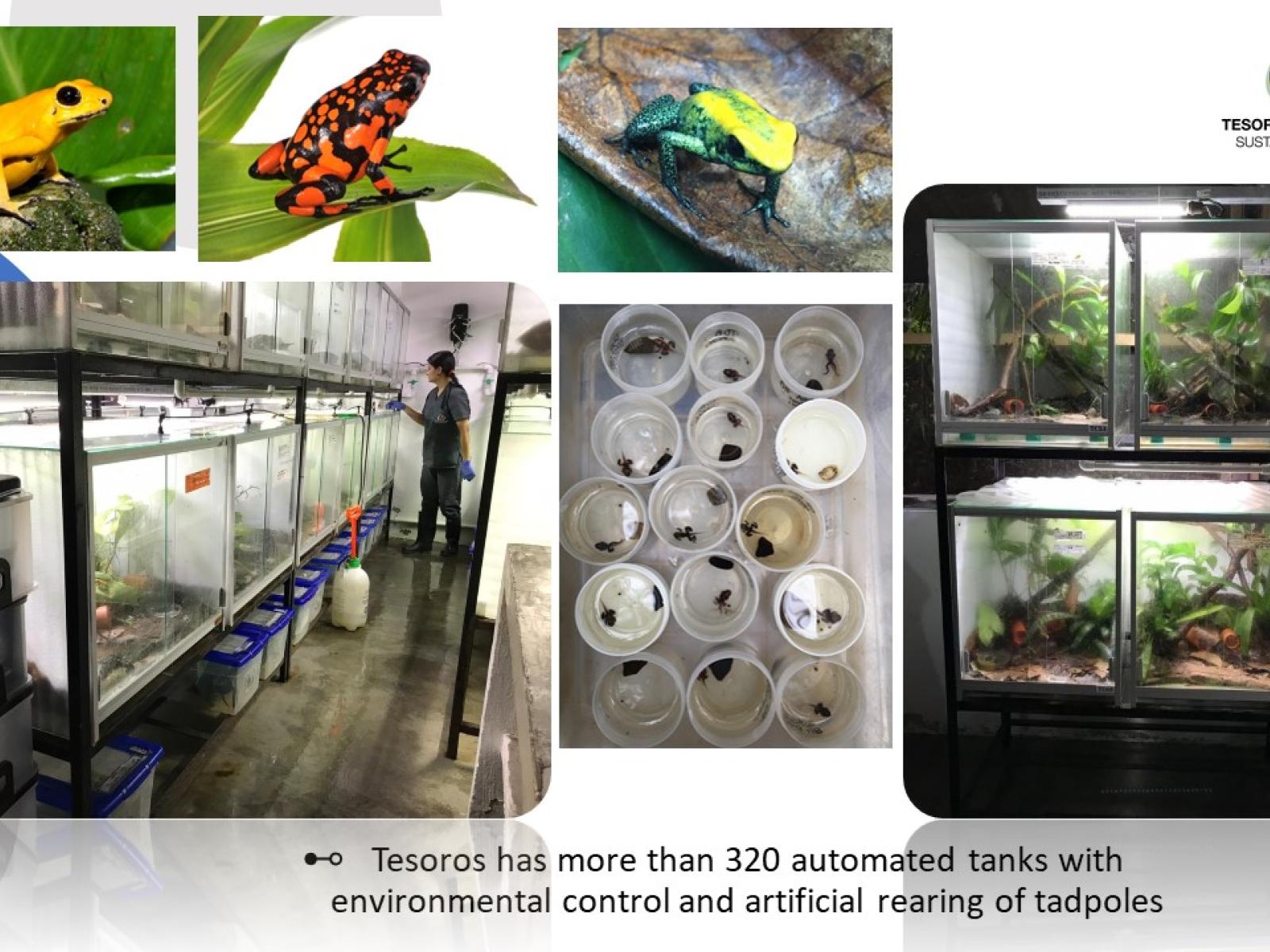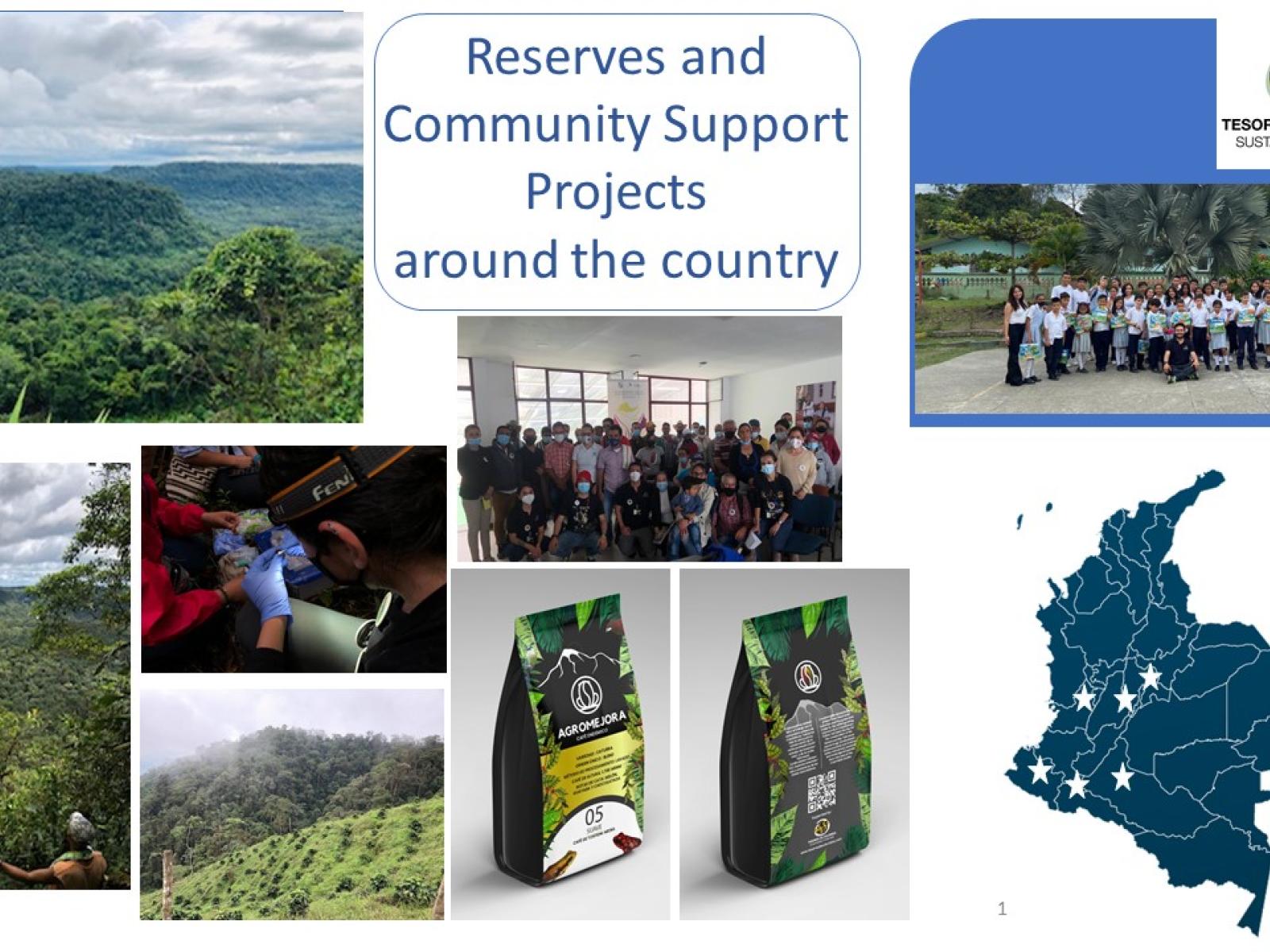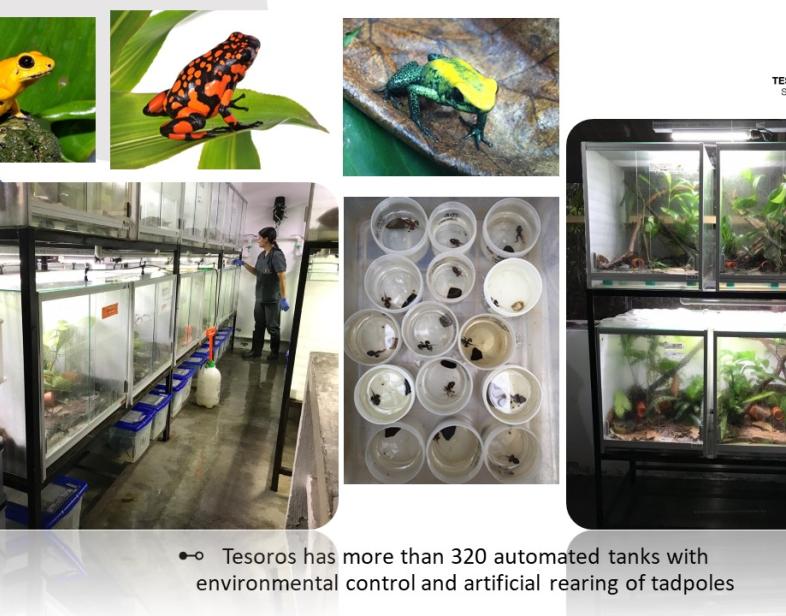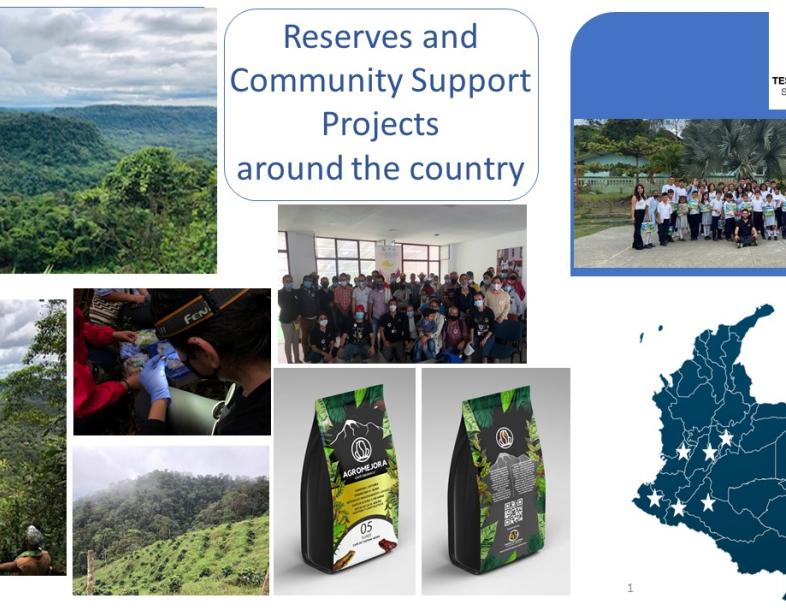An Overview Of Our Solution
Tesoros de Colombia Sustainable Farm is a conservation project focused on protecting wildlife species from overexploitation for the illegal international trade and habitat loss. For 12 years has been breeding and legally exporting seven species of poison frogs historically overexploited for the illegal market. Tesoros was created by expert conservationists with the mission of supply the international demand and establish a legal market stopping the smuggling that threats the species. Since Tesoros developed the breeding protocols and started exporting, the confiscation of frogs for the international market in Colombia and other countries dropped to zero (since 2019). Tesoros also supports national and international authorities and it is a perfect example of a practical, sustainable solution that includes local communities to actively save species from extinction.
- Population Impacted: 10000
- Continent: South America
First name
Last name
Organization type
Email Address
Context Analysis
Colombia as a world biodiversity power that still has a big debt toward supporting the Biocommerce or Biotrade as a sustainable tool. Wildlife farming is still underdeveloped mainly because the lack of understanding and support from the environmental authority’s system of the country. The specific regulations (Environmental license) required for stablishing such a project is the same as high impact industry or project like mining or oil production.
Also, the regional environmental authorities that control these activities are not supportive even as they get the benefits of a private party doing part of their job: to promote and protect wildlife populations using expert captive breeding. In the case of Tesoros, it took almost ten years to get the full licensing while the time expected in the regulations was a maximum of 3 1/2 years. The consequences of this delay almost put an end to the project several times for the impossibility of funding it by other means of getting expensive loans.
Meanwhile, thousands of frogs were smuggled out of Colombia each year through international airports where some were confiscated. At the Bogota international airport in 1998 more than 600 arlequin poison frogs and 300 lehmann’s poison frogs were confiscated and more recently in 2018 and 2019, more than 450 arlequin and 200 lehmann poison frogs respectively were confiscated.
This situation clearly has a consequence on theses frog’s population declination. In 2020 a scientific article published by Betancourth-Cundar et al, suggested that more than 80,000 of these frogs were illegally extracted from their only natural habitat in Colombia in the last four decades. According with the experts, no more than 5000 adults of these species remain in the wild so this overexploitation clearly is driving this species close to extinction.
Tesoros de Colombia was the first project to breed permanently these species in captivity in the world thanks to developing succesful husbandry protocols.
Video file
Describe the technical solution you wanted the target audience to adopt
We believe that according with the sustainability basis many commercial demands can be met easily by identifying the best way to supply it via applied knowledge, in this case a scientific one. We started Tesoros believing that some pairs of these frogs, managed by experts, could help to preserve their species in the wild not just by breeding but by generating a cascade effect that could replace those that were smuggled while generating enough funds to pay the expenses of captive breeding and support conservation projects in situ.
The international community that keeps these frogs are constituted by zoological institutions, aquariums, other education institutions and private collectors that refer to this activity as a hobby including tens of thousands of enthusiasts worldwide.
By providing ethical, legal and healthy young frogs to a market that in the past used to get sick, injured smuggled animals we wanted to change for good the sustainability of it.
Describe your behavioral intervention.
While getting the license we studied the probable size of the market, the actors and the possible strategy of communication and education to switch the international market from illegality to a legal one based on ethics, legality and quality.
At the beginning of Tesoros exports the international market reacted mostly positively, we were aware that there was a long-time smuggling occurring and of course we faced criticism from people that wanted things to stay as usual for their own interests.
We have witnessed how in less than a decade the +5000 frogs we have bred and distributed in 3 continents have bred there with our support and replaced the traditional smuggled ones in social media, shows and posters in conservation institutions been called the “Tesoros line” while our efforts have appeared in more than 500 media of +100 countries from all over the world including the BBC, National Geographic Magazine, the New York Times and the Washington Post. This, added to more than 40 lectures in 10 countries about Tesoros efforts and international alliances and cooperation with several zoological institutions around the world have grown a solid image of leading sustainable biocommerce from Colombia.
Now, the international hobby is coming toward a conservation posture, with hundreds of supporters for the In Situ conservation of the species they keep and far from the historic utilitarian posture from the last decades thanks to this permanent and strong message from Tesoros.
Behavioral Levers Utilized
Video file
Describe your implementation
We started by reviewing the existent Colombian regulations in order to fit the project into them and spent a long time creating the application for the national environmental license.
After more than two years of dealing with many bureaucratic obstacles, in 2008 we got the license to build the facilities, set up and start the project but they only included one species of frog to be bred out of seven we asked for inexplicably. Only in 2015 we got fully licensed and got the yearly quotas to export seven species of frogs. That 6 year delay brought a difficult financial situation that only our own family money and several big loans kept the project going. Today we still owe a lot of money but we couldn’t stop the project as we were having good results breeding some critically endangered species that were not bred anywhere else.
By giving dozens of lectures in several countries and supporting the breeders we managed to attract the enthusiast of the frog keepers toward the Insitu conservation of the frogs via our own projects that involve local communities throughout the country:
- Land purchasing for the enlargement of the Oophaga sylvatica poison frog reserve in Barbacoas, Nariño Department.
- Supporting the coffee producers in Casabianca, Tolima who are helping protect the endangered Andinobates tolimensis and Andinobates dorisswansonae poison frogs through habitat conservation and better production practices.
- Habitat restoration in our own reserve of low Andean Forest for more than 150 species of vertebrates and environmental education of the community in Nocaima, Cundinamarca
- Support with equipment and funds for the field research of the herpetological group of the Amazonian University in Caquetá and Putumayo, Amazonian Departments.
- Funding the training of the community to start the local ecotourism project in Atuncela, Valle Del Cauca
- Financial support for La Reserva Biopark Foundation conservation programs, Cota Cundinamarca
Describe the leadership for your solution. Who is leading the implementation?
We have a team of young passionate people, mostly women and the majority of them native from the region where the farm is located (Nocaima, Cundinamarca).
The leading team is completed with two animal scientists, an ecologist, two veterinarians, a team of young women keepers and maintenance staff. We also have a team of consultants that includes expert biologists, environmental engineers, lawyers and a human resources team.
The founder and general manager of Tesoros is Ivan Lozano Ortega, a well-known animal scientist, expert conservationist, university lecturer that has an experience of almost 30 years in several countries acting as an international consultant on wildlife management and conservation. He also founded and is the director of La Reserva Biopark Foundation in Colombia (www.bioparquelareserva.com). (www.ivanlozano.co)
Share some of the key partners or stakeholders engaged in your solution development and implementation.
We have always supported the conservation efforts carried on by all the national and international authorities.
In the case of CITES (Convention on International Trade in Endangered Species of Wild Fauna and Flora) we have supported them permanently with key information to help control the illegal trade. We gave a lecture about the Tesoros work and the development of our husbandry techniques at the 90th Meeting of the CITES Scientific Review Group held in Brussels in 2020 and shared with all the officers the document “Tesoros de Colombia large oophaga husbandry and breeding information, for official use only” in order to support their work on controlling the private collections of Colombian species of frogs internationally. (https://ec.europa.eu/transparency/expert-groups-register/screen/meetings/consult?lang=en&do=groupDetail.groupMeeting&meetingId=21093)
We also designed a tool to control all the frogs of the Oophaga species bred by us. Our Oophaga database located at our website, let all the authorities and customers check the individual Identification of each frog exported from us with a set of pictures, description and a unique code avoiding any supplantation. These frog ID´s are sent to the CITES authorities of before sending the shipments of the frogs so its easy for them to check the transparency of the origin and the legal international trade.
In Colombia we have supported the national and international authorities. Through a local program a few years ago and in an alliance with the Environmental Ministry and the INTERPOL, we taught several courses to Police, attorneys and judges about international wildlife trafficking focusing on amphibians. We also were instructors in several Diploma courses of Colombian universities about illegal trade control for national authorities.
We have even support the national police K9 program by helping them training police dogs to find live frogs inside luggage at the airport.
Who adopted the desired behavior(s) and to what degree? Include an explanation of how you measured a change in behavior.
Zoological institutions: Many in several countries are now only exhibiting and housing Tesoros frogs as they wanted to have certified legal captive bred frogs only. Also, we have sent dozens of frogs to institutions in Colombia and other countries for free on our Tesoros Zoo Program.
Private breeders and Hobbyists: We believe that only the frogs bred in Colombia that have a CITES certification can be considered completely legal. Nowadays it seems that the majority of the international hobby community share this position as even in shows that had suspicious frog sales, the "Tesoros line" frogs now completely dominates the market.
Local Communities: after several meetings with communities in various localities of Colombia, we have explained the convenience of our sustainability and biocommerce vision for their own benefit. The communities understood and joined in to support the conservation of the species actively as they see and enjoy the benefit of this interaction.
How did you impact the environment (biodiversity conservation, ecosystems, etc.)? Please be specific and include measurement methodology where relevant.
The most important environmental impact is promoting the stop of the illegal frog collection in the wild, as we believe that millions of poison frogs have been collected from the wild for the international trade in the last 45 years after it became illegal. Now, some populations are thriving even though many are facing other threats like habitat destruction and the chytrid fungus infections. This is why we created and funded several in situ conservation projects for endangered ecosystems in several areas of the country. We believe that this project can be an enormous source of information, frogs for restocking and funds to help palliate the actual amphibian crisis that is affecting this group of animals in Colombia.
How has your solution impacted equity challenges (including race, ethnicity, social class/income, indigenous communities, or others)?
We are working with species that are surrounded by many ethnic groups in Colombia. Our first step of creating a legal and ethic biocommerce has achieved great results and therefore we are now wanting to increase and improve our in-situ work. We know that this work has to include local communities if we want to achieve better results protecting the habitats were these frogs and thousands of wild species live. For example, in the case of the almost 100 families of farmers in Casabianca, Tolima we have supported them to improve the quality of their coffee, the packing and its image by funding workshops and specialized training. We also are promoting this coffee in United States as we want to help them to export their coffee earning a better income for it. What we ask in consideration from the community is to help protect two endemic species of poison frogs, the Tolima and the dotted poison frogs (Andinobates tolimensis and Andinobates dorisswansonae).
What were some social and/or community co-benefits?
With these projects and the frogs protected in their habitat the communities enjoy a healthy, diverse environment instead of depleting the natural resources implementing traditional activities while accesing to other forms of support via the interaction with Tesoros.
This can be support to other economic activities and visibility for international grant applications.
What were some sustainable development co-benefits?
Habitat protection and restoration through the cooperation with communities and experts in different parts of the country with the enhancement of the ecosystem services production.
Education and training in conservation and sustainability for hundreds of families in several Colombian communities.
Research and information sharing regarding the husbandry and breeding of endangered species of frogs.
A model of a sustainable biocommerce project that can be replicated.
Sustainability: Describe the economic sustainability of your solution.
Tesoros de Colombia was created to prove that a well developed biocommerce project could be economically sustainable with a Market based revenue. We believe that this is the path for other biocommerce projects involving private investors as these activities will have a positive impact on the environment, the wildlife and the local communities.
If conservation projects can have its own funding, total or partial, ther could be more interest in developing new ones.
Return on investment: How much did it cost to implement these activities? How do your results above compare to this investment?
According with our original business plan we should have found a breakeven point in a couple of years after being full licensed according with the time line and terms from the Colombian law but due to all the delays in obtaining the license it took more than 10 years. We still believe that this project is a winner pilot project to show what a country like Colombia should promote with its abundant biodiversity but the lack of knowledge on sustainable use and development on our regulatory and environmental authority system makes it difficult.
More than $400,000 have been invested in the project and we are still paying original loans. We believe that in 2025 we will have profit including the costs of funding the In situ projects.
How could we successfully replicate this solution in Latin America?
Absolutely replicable and convenient to most of Latin America countries where wildlife has been extensively unsustainably used locally and internationally as practical conservation solutions like these can protect populations of many species that have commercial interest.
Our suggestion for the future development of this model elsewhere is to have a public/private alliance or support with clear and easy to follow national and regional regulations and political will.
Experts, private investors and environmental authorities can join together or become supporters to develop more similar programs as it is stated on international agreements signed by several Latin America countries. There is a lot of communities that could benefit from this kind of sustainable activities while protecting wildlife and avoiding the implementation of economic activities that are deleterious for the environment as we can actually see everywhere.
